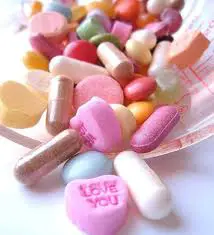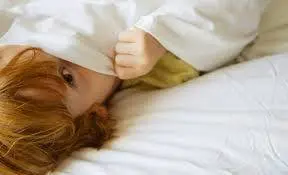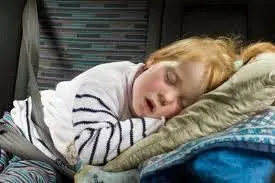Tacs, M&M’s, Mike N’ Ikes, Good N’ Fruity, Sweet Tarts, Skittles, even chocolate — the list goes on. Look in a medicine aisle and you’ll find a medication that looks nearly identical to many popular candies. Packaging removed, many adults can’t even tell the difference between candy and pills. Mix that with the impulsive sweet-tooth of most kids, and you have a recipe for misfortune and a serious reason to practice some medication safety for kids. One out of every 250 2-year-olds ends up in the ER from accidental medication poisoning.
So how can you keep your child from mistaking medicine for candy?
Medication Safety for Kids:
-Teach your child a symbol that means something is icky, a no-no, and dangerous. Since many poisonous substances already use the skull and crossbones, you can add this symbol to your medications, pills, and other hazards for children such as make-up, toiletries, and cleaning supplies. Make the symbol big and on neon paper if possible. You want it to really stand out. Be clear to your child that they should never touch anything that has this symbol. You can also buy stickers if you prefer.
-Avoid referring to medications or pills as “candy.” While I realize children often make this association themselves (my toddler calls his Flintstone vitamins candy), never tell your child a pill is candy to get them to take it. If they do mistake a medication for candy, correct them. Teaching that there is a difference between medicine and candy from the very beginning is important.
-Teach your kids never to eat candy off the floor. My toddlers eat off the floor all the time, it’s an effect of constantly throwing food. However, teaching that all foods should pass a mom/dad inspection can prevent accidental poison or medication ingestion. This one can take time, so in the meantime, keep a close eye on younger children, especially when in public places or locations like hotel rooms where you may not know who all has been there.
-Try to take your medicine out of your child’s sight. Young children in particular, as you likely have noticed, are mimics. Anything you do they’ll not only want to do, but likely will try to do. Simply taking your pills out of your child’s sight can help tremendously when your aim is medication safety for kids.
-Buy child-resistant packaging, and be sure the bottles are closed after use. Most medications now come with tamper-resistant or child-proof packaging, but some don’t. Be on the look-out for packaging that is extra tricky to open, the more difficult the better. Also be sure you properly close medication after use. My very first scare with my toddler and pills was due to me not fully placing the lid back on my Advil. Luckily he didn’t consume any, but if the cap isn’t secure, child resistant packaging doesn’t work, so check it twice. Also be sure to always keep medication in its original, safe package with the added no-no label.
-Keep medication in a locked location well above your child’s reach. When it comes to preventing accidental poisonings and medication safety for kids, you really can’t be too careful. Place those child-proof bottles and packages in a locked location that is well above your child’s reach, such as a bathroom cabinet above the mirror or toilet or on a high shelf.
What should you do if you suspect your child ate a pill or medication?
Don’t wait to see if your child has a reaction. Many medications will show little to no symptoms, but can be fatal over time. If you know the medication or pill that was or possibly was ingested, call poison control at 1-800-222-1222 in the US for instructions and follow them. If you’re unsure of the pill or medication taken, grab any remains — even if it’s covered in spit and is half-eaten — and go immediately to the ER. Also try to remember or even write down what the substance looked like in detail, so you can provide hospital staff with accurate information.



